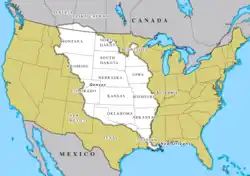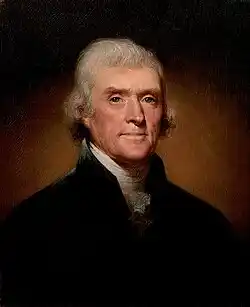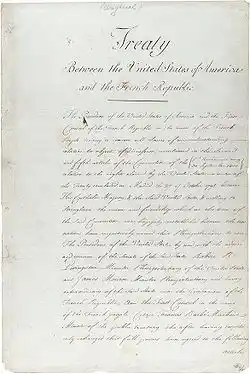
The Louisiana Purchase was a land transaction which occurred in 1803 when the government of France sold the Louisiana territory to the United States. This encapsulated much more than the modern-day state of Louisiana. The land nominally covered more than two million square kilometers and covered all of parts of the states of Louisiana, Arkansas, Oklahoma, Missouri, Kansas, Colorado, Iowa, Nebraska, Wyoming, North Dakota, South Dakota and Montana. In purchasing this vast territory, which was still inhabited by various Native American groups, the United States paved the way for its further westwards expansion into the Great Plains in the north and west of the Mississippi River in the south. That process would not begin for the most part until after the Mexican-American War of 1846 to 1848 and the opening of the American West. Nevertheless, anyone whose ancestors settled west of the Great Lakes and the Mississippi River in the second half of the nineteenth century was essentially moving to these regions as an indirect result of the Louisiana Purchase.[1]
Research your ancestors on MyHeritage
Louisiana Purchase chronology of eventsLouisiana Purchase chronology of events
When the United States came into existence in 1776 it consisted of a strip of thirteen states all lying along the eastern seaboard of the United States. Some settlers had begun to move westwards beyond the Cumberland Gap and the Appalachian Mountains to explore and settle what subsequently became Kentucky and Tennessee, but for the most part the young country was an Atlantic one. That changed over the next half a century. As new settlers arrived from Europe and the existing population continued to grow at unprecedented speed, Americans moved further westwards in search of new lands.[2]
At the same time, there was an impediment to westward expansion. The French had begun in the late seventeenth century to try and encircle the British colonies in North America by settling at the mouth of the Mississippi River around New Orleans and then expanding up the Mississippi and the Ohio River to the Great Lakes. These lands were ceded to Spain by France in 1762 during the Seven Years’ War. Thus, as well as the Native Americans who lived west of the Appalachian Mountains, the new country had to contend with competing Spanish territorial claims if it was to continue expanding westwards.[3]

An opportunity to acquire the Louisiana territory emerged as a result of developments in Europe. The French Revolutionary Wars broke out in Europe in 1792. During these, and the subsequent Napoleonic Wars, Britain would remain almost constantly at war with France. However, the French effectively took over Spain in the course of these wars and in 1800 the Spanish monarchy regranted the Louisiana territory to the French. Still, such was the power of the British Royal Navy and its dominance of the world’s seas that France was virtually permanently cut off from Louisiana.[4]
In this environment the French government of Napoleon Bonaparte began to consider the possibility of divesting itself of the Louisiana territory which it had only recently reacquired, which in any event was more of a theoretical colonial land mass than a real one. Other than the city of New Orleans, some estates in the bayou region of modern-day Louisiana and some forts and trading stations up the course of the Mississippi and Ohio Rivers, there was little French settlement.[5]

The Louisiana Purchase was driven by President Thomas Jefferson who watched the political developments in Louisiana and in Europe closely during the presidency of his predecessor, John Adams. In 1802 the French briefly agreed peace terms with Britain through the Treaty of Amiens, allowing them to re-establish contact with their American territories in the Caribbean and Louisiana. This only lasted for 14 months before war resumed between the British and French in May 1803. Once this occurred talks between Bonaparte’s and Jefferson’s governments accelerated and in July a deal was struck for France to sell to the United States the vast Louisiana territory.[6] Over two million square kilometers covering most of the states of Louisiana, Arkansas, Oklahoma, Missouri, Kansas, Colorado, Iowa, Nebraska, Wyoming, North Dakota, South Dakota and Montana were ceded to the US for a fee of fifteen million dollars. This was a fantastic deal, equivalent to around half a billion dollars in modern monetary terms.[7]
Extent of migration following the Louisiana PurchaseExtent of migration following the Louisiana Purchase
The completion of the Louisiana Purchase did not lead to mass migration from the United States into the newly acquired lands. Americans had not yet really settled places like Illinois, Wisconsin, Alabama and the western parts of Kentucky and Tennessee in large numbers, so the purchase of these lands even further west was more like future planning. Indeed, the exact geography and nature of much of the lands that had been acquired were not even well known. Hence, the first thing which Jefferson’s government did was order an expedition of exploration led by Meriwether Lewis and William Clark to proceed through the Great Plains and westwards through Montana to the Pacific Ocean.[8]
The settlement of the lands acquired through the Louisiana Purchase largely began in the 1830s when the government forcibly removed the Native Americans of states like Tennessee and Alabama to Oklahoma and surrounding regions. The period of really intense settlement of the lands obtained from France in 1803 commenced in the 1850s after the opening of the American West with the Mexican-American War of 1846 to 1848 and the California Gold Rush. Hundreds of thousands of Americans and Europeans settled in the lands of the Louisiana Purchase in the decades that followed and millions more passed through on their way further west to Texas, California, Oregon and others regions. The Louisiana Purchase was a key part of one of the great migrations of modern history.[9]
Demographic impact of the Louisiana PurchaseDemographic impact of the Louisiana Purchase
The short-term demographic impact of the Louisiana Purchase was limited. However, in the long run it transformed the demographic landscape of North America. Had it not occurred the United States would have been blocked from further westwards expansion, though it most likely would have resorted to war or some other method to acquire these lands from France if the French had refused to sell them. From the 1830s onwards American settlers began colonizing parts of Arkansas, Missouri and Iowa and then moved further west every decade. By the end of the nineteenth century there were over ten million Americans and settlers of European heritage living between the Great Lakes and the River Mississippi west to the Pacific Ocean. That would not have been possible without the Louisiana Purchase. Thus, the 1803 land transaction drastically altered the history and settlement of North America.[10]
See alsoSee also
Explore more about the Louisiana PurchaseExplore more about the Louisiana Purchase
- Louisiana, Orleans Parish, Births records collection on MyHeritage
- Louisiana, Orleans Parish, Marriages records collection on MyHeritage
- Louisiana, Death Index, 1819-1969 records collection on MyHeritage
- 1810 United States Federal Census records collection on MyHeritage
- 1850 United States Federal Census records collection on MyHeritage
- 1850 United States Federal Census (Slave Schedule) records collection on MyHeritage
- Western United States, Marriage Index, 1838-2016 records collection on MyHeritage
- Service Records of Confederate Soldiers records collection on MyHeritage
- Louisiana, New Orleans, Passenger Lists records collection on MyHeritage
- Afro-Louisiana History and Genealogy, 1718-1820 at Legacy Family Tree Webinars
References
- ↑ https://www.smithsonianmag.com/history/how-the-louisiana-purchase-changed-the-world-79715124/
- ↑ https://dev.ncpedia.org/anchor/united-states-1790s
- ↑ https://www.hnoc.org/publications/first-draft/how-did-louisiana-become-spanish-new-video-tells-story-behind-transfer
- ↑ https://www.napoleon.org/en/history-of-the-two-empires/articles/the-british-navy-1793-1802/
- ↑ https://www.napoleon.org/en/history-of-the-two-empires/articles/louisiana-to-have-and-to-have-not/
- ↑ https://www.monticello.org/thomas-jefferson/louisiana-lewis-clark/the-louisiana-purchase/
- ↑ https://www.history.com/topics/19th-century/louisiana-purchase
- ↑ https://www.oregonencyclopedia.org/articles/lewis_and_clark_expedition/
- ↑ https://www.historyonthenet.com/american-west-timeline
- ↑ https://www.smithsonianmag.com/history/how-the-louisiana-purchase-changed-the-world-79715124/

